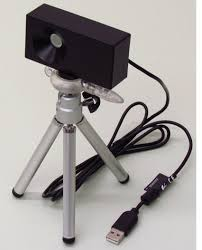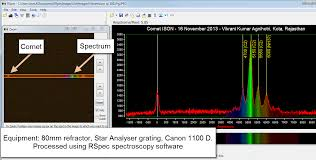RSpec-Explorer
By Edwin P. Christmann
Posted on 2015-04-09
The RSpec-Explorer is a small, portable spectroscopy camera that connects to a computer. It can be used for measuring spectra from light sources (including flames, screens, etc.) and for evaluating the emission signature from gas tubes.
The software package can be downloaded from www.fieldtestedsystems.com/getrex, which offers a free 30-day trial before a license purchase is required. Once downloaded, the camera is connected to a computer via a USB cable. After the USB cable is connected, videos and images can be recorded/captured and saved. Subsequently, both the image from the camera and the corresponding spectra can be viewed simultaneously; from either the saved image/video file or from a live feed. In addition, images can be imported for spectral analysis and the files can be read in both .bmp and .jpeg formats.

Another nice feature is the ability of the RSpec-Explorer to handle FITS data files, which are common in the field of astronomy. Therefore, images captured by NASA’s Hubble telescope and other astronomy sources can be imported and analyzed by allowing you to import and export data points into the program for analysis.
[youtube]https://www.youtube.com/watch?v=eLzZwrOBaaU[/youtube]
The spectrograph is also highly customizable with a variety of features that allow the user to select a part of an image or camera view for analysis. Spectral data can be saved on the graph and overlaid with other emission spectra to cfor the sake of comparison. Another nice feature is the zoom features that allow you to get a closer look at different parts of the spectrograph. Once captured, the spectrograph can be saved or copied, and inserted into almost any document type. The camera automatically adjusts for different light inputs and reduces external light noise with several manual adjustments. The device can be calibrated for more precise readings as well.

Overall, the RSpec-Explorer is very easy to use—only minimal setup is required to begin displaying and analyzing spectra. In addition, the wide variety of options for calibration and customization of views gives this device the ability to do precision work. The device is sturdy and functioned well in a classroom setting. The estimated cost for the camera, tripod and software is $395, which make it an affordable choice for teacher demonstrations.
Our thanks to Arbor Scientific for making the Rspec-Explorer available for review.
Edwin P. Christmann is a professor and chairman of the secondary education department and graduate coordinator of the mathematics and science teaching program at Slippery Rock University in Slippery Rock, Pennsylvania, Corissa Fretz is a graduate student and a research assistant in the mathematics and science teaching program at Slippery Rock University in Slippery Rock, Pennsylvania, and Katherine Wingard is a graduate student and a research assistant in the mathematics and science teaching program at Slippery Rock University in Slippery Rock, Pennsylvania
Disclaimer: The views expressed in this blog post are those of the author(s) and do not necessarily reflect the official position of the National Science Teaching Association (NSTA).


